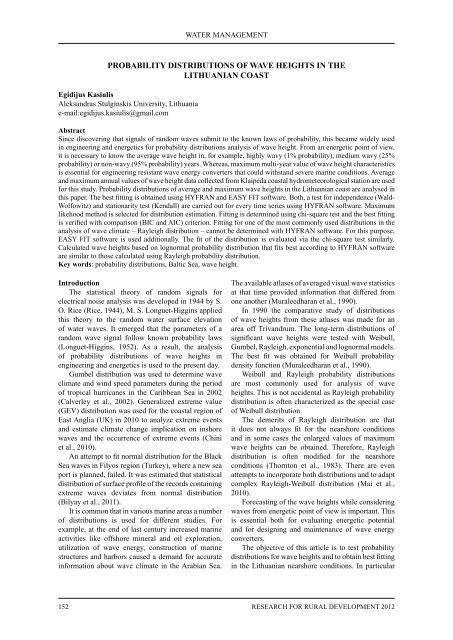RESEARCH FOR
RESEARCH FOR
RESEARCH FOR
Create successful ePaper yourself
Turn your PDF publications into a flip-book with our unique Google optimized e-Paper software.
probabIlIty dIstrIbutIons of Wave HeIgHts In tHe<br />
lItHuanIan coast<br />
egidijus Kasiulis<br />
Aleksandras Stulginskis University, Lithuania<br />
e-mail:egidijus.kasiulis@gmail.com<br />
abstract<br />
Since discovering that signals of random waves submit to the known laws of probability, this became widely used<br />
in engineering and energetics for probability distributions analysis of wave height. From an energetic point of view,<br />
it is necessary to know the average wave height in, for example, highly wavy (1% probability), medium wavy (25%<br />
probability) or non-wavy (95% probability) years. Whereas, maximum multi-year value of wave height characteristics<br />
is essential for engineering resistant wave energy converters that could withstand severe marine conditions. Average<br />
and maximum annual values of wave height data collected from Klaipėda coastal hydrometeorological station are used<br />
for this study. Probability distributions of average and maximum wave heights in the Lithuanian coast are analysed in<br />
this paper. The best fitting is obtained using HYFRAN and EASY FIT software. Both, a test for independence (Wald-<br />
Wolfowitz) and stationarity test (Kendall) are carried out for every time series using HYFRAN software. Maximum<br />
likehood method is selected for distribution estimation. Fitting is determined using chi-square test and the best fitting<br />
is verified with comparison (BIC and AIC) criterion. Fitting for one of the most commonly used distributions in the<br />
analysis of wave climate – Rayleigh distribution – cannot be determined with HYFRAN software. For this purpose,<br />
EASY FIT software is used additionally. The fit of the distribution is evaluated via the chi-square test similarly.<br />
Calculated wave heights based on lognormal probability distribution that fits best according to HYFRAN software<br />
are similar to those calculated using Rayleigh probability distribution.<br />
Key words: probability distributions, Baltic Sea, wave height.<br />
Introduction<br />
The statistical theory of random signals for<br />
electrical noise analysis was developed in 1944 by S.<br />
O. Rice (Rice, 1944), M. S. Longuet-Higgins applied<br />
this theory to the random water surface elevation<br />
of water waves. It emerged that the parameters of a<br />
random wave signal follow known probability laws<br />
(Longuet-Higgins, 1952). As a result, the analysis<br />
of probability distributions of wave heights in<br />
engineering and energetics is used to the present day.<br />
Gumbel distribution was used to determine wave<br />
climate and wind speed parameters during the period<br />
of tropical hurricanes in the Caribbean Sea in 2002<br />
(Calverley et al., 2002). Generalized extreme value<br />
(GEV) distribution was used for the coastal region of<br />
East Anglia (UK) in 2010 to analyze extreme events<br />
and estimate climate change implication on inshore<br />
waves and the occurrence of extreme events (Chini<br />
et al., 2010).<br />
An attempt to fit normal distribution for the Black<br />
Sea waves in Filyos region (Turkey), where a new sea<br />
port is planned, failed. It was estimated that statistical<br />
distribution of surface profile of the records containing<br />
extreme waves deviates from normal distribution<br />
(Bilyay et al., 2011).<br />
It is common that in various marine areas a number<br />
of distributions is used for different studies. For<br />
example, at the end of last century increased marine<br />
activities like offshore mineral and oil exploration,<br />
utilization of wave energy, construction of marine<br />
structures and harbors caused a demand for accurate<br />
information about wave climate in the Arabian Sea.<br />
WATER MANAGEMENT<br />
The available atlases of averaged visual wave statistics<br />
at that time provided information that differed from<br />
one another (Muraleedharan et al., 1990).<br />
In 1990 the comparative study of distributions<br />
of wave heights from these atlases was made for an<br />
area off Trivandrum. The long-term distributions of<br />
significant wave heights were tested with Weibull,<br />
Gumbel, Rayleigh, exponential and lognormal models.<br />
The best fit was obtained for Weibull probability<br />
density function (Muraleedharan et al., 1990).<br />
Weibull and Rayleigh probability distributions<br />
are most commonly used for analysis of wave<br />
heights. This is not accidental as Rayleigh probability<br />
distribution is often characterized as the special case<br />
of Weibull distribution.<br />
The demerits of Rayleigh distribution are that<br />
it does not always fit for the nearshore conditions<br />
and in some cases the enlarged values of maximum<br />
wave heights can be obtained. Therefore, Rayleigh<br />
distribution is often modified for the nearshore<br />
conditions (Thornton et al., 1983). There are even<br />
attempts to incorporate both distributions and to adapt<br />
complex Rayleigh-Weibull distribution (Mai et al.,<br />
2010).<br />
Forecasting of the wave heights while considering<br />
waves from energetic point of view is important. This<br />
is essential both for evaluating energetic potential<br />
and for designing and maintenance of wave energy<br />
converters.<br />
The objective of this article is to test probability<br />
distributions for wave heights and to obtain best fitting<br />
in the Lithuanian nearshore conditions. In particular<br />
152 ReseaRch foR RuRal Development 2012


